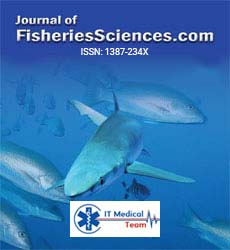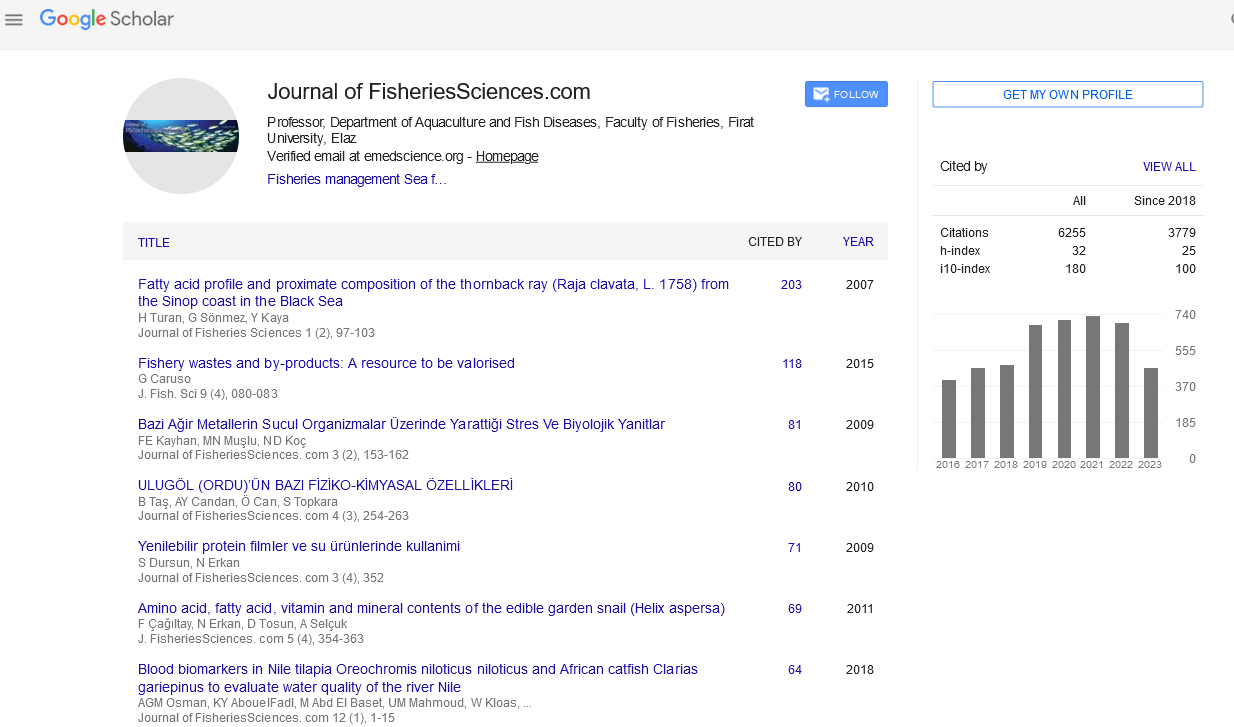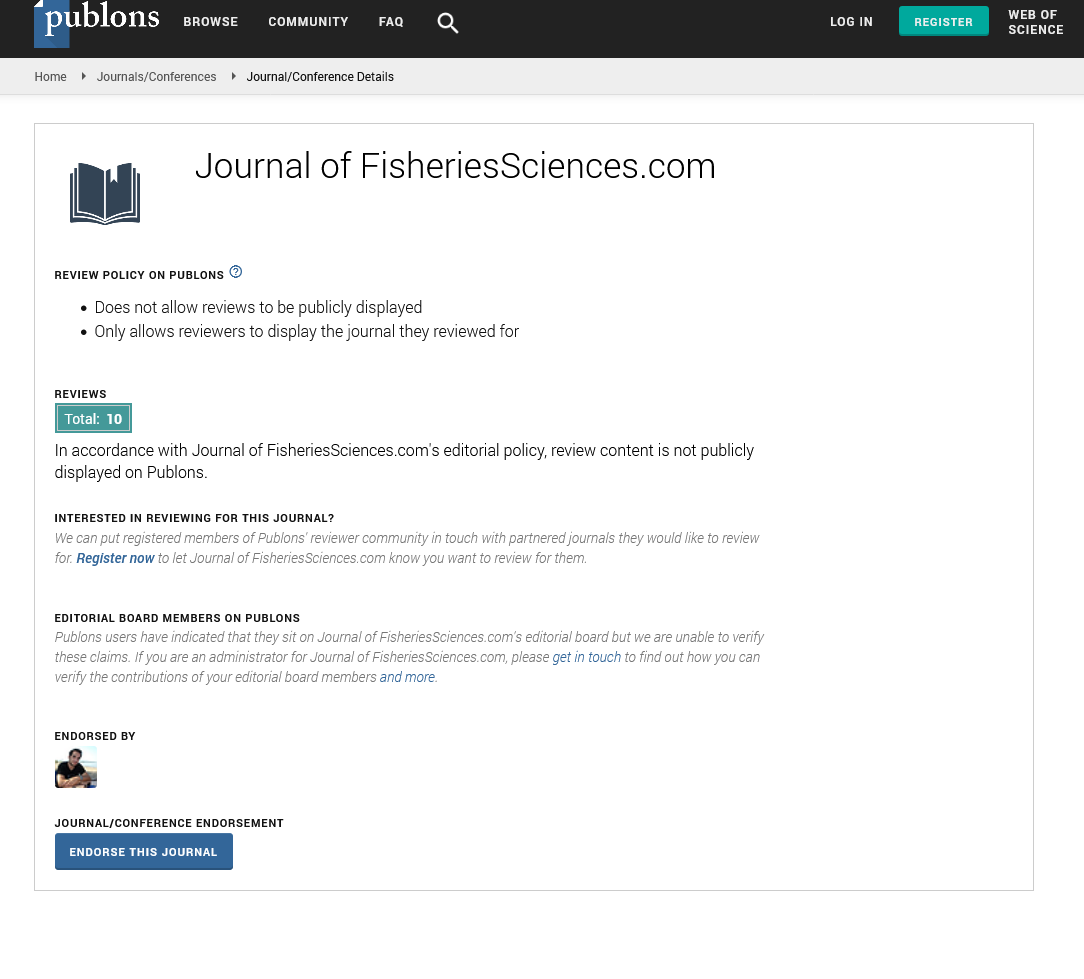Mini Review - (2023) Volume 17, Issue 3
Effects of pH and Air on the Transformation of Podocysts in Edible Cephalopods
Aftab Alam*
Fisheries Department, Southwest Area Integrated Water Resources Planning and Management Project, Bahrain
*Correspondence:
Aftab Alam, Fisheries Department, Southwest Area Integrated Water Resources Planning and Management Project,
Bahrain,
Email:
Received: 02-Mar-2023, Manuscript No. ipfs-23-13589;
Editor assigned: 06-Mar-2023, Pre QC No. ipfs-23-13589;
Reviewed: 20-Mar-2023, QC No. ipfs-23-13589;
Revised: 24-Mar-2023, Manuscript No. ipfs-23-13589;
Published:
31-Mar-2023, DOI: 10.36648/1307-234X.23.17.3.115
Abstract
Rhopilema esculentum is one of the edible cephalopods, a traditional Chinese fishery resource and an important economic aquaculture species. However, given the current natural resource depletion and frequent disease problems in breeding populations, the quantity and quality of seedlings in artificial propagation cannot meet market demand. Temperature and salinity have been hypothesized to play important roles in regulating asexual reproduction in R. esculentum. In this study, we investigated the combined effects of exposure to R after preservation. esculentum podocysts (stored at 2 ± 1 °C for more than 12 months) to three variable temperatures (14.5 °C on April 1, 18 °C on May 1, and 23.2 °C on July 1). simulated temperature obtained from the start date), corresponding to natural levels) and three salinities (20, 25, and 30). We tested podocyst excystation, strobilation onset time, strobilization duration, and cumulative number of efia over 45 days, and analyzed the rate of migration from podiatric to efia to determine the optimal combination of temperature and salinity. Results showed that popodocyst excystation and ephia production occurred with all treatments. Higher temperature and lower salinity significantly accelerated postcyst excystation and accelerated the onset of strobilation (p<0.05). Lower salinity (20 and 25) produced significantly larger ephyra numbers when the temperature increased from 18 °C on May 1 to natural values (p<0.05). There was a significant interaction between temperature and salinity in cumulative ephyra counts and podocyst-to-ephyra transmission rates (p<0.05). These results suggest that R. esculentum podocysts can be recycled for long-term cryopreservation. Temperature and salinity adjustments can influence the number and timing of R. esculentum seedlings to achieve high production and meet market demand for real-time seedling supply. This conclusion provides a scientific basis for innovative methods for sustainable utilization of edible cephalopod (R. esculentum) resources.
Keywords
Economic cephalopods; Experimental ecology; Control technology;
Polyps; Asexual reproduction; Resource utilization
Introduction
Rhopilema esculentum is one of the most important species for
Chinese traditional fisheries, artificial improvement and pond
aquaculture, with an annual production value of over 10 billion
yuan. R. esculentum medusae are nutritious, low in fat, tasty and
play a healthy role in disease prevention. In recent years, it has
also developed into cosmetics and health products, increasing its
economic value and broad market prospects. Compared to other farmed species such as fish, shrimp and crabs, R. esculentum
medusae is a fast growing, short breeding cycle, low cost, fast
results and high profit [1]. In some provinces of China (Liaoning,
Shandong, Jiangsu, etc.), the release of pond-improved R.
esculentum medusae has become a distinctive industry. Related
industries such as fisheries, aquaculture, processing and trade,
especially seedling breeding, which is an important base for his
entire R. esculentum industry, have significant social, economic
and environmental benefits. In the current traditional seedling cultivation, a large amount of polyps has been obtained by
capturing adult jellyfish in batches in a tank of a breeding facility
in autumn. These polyps were then fed to grow by overwintering
and began releasing efia as temperatures rose in the spring.Once
strobilation is complete, these polyps and their popodocysts
are discarded. Podocist breeding was therefore not used in the
breeding process. However, giant cephalopod podocysts play an
important role in the proliferation of polyps, and even in ephyrial
populations [2]. Nemopilema nomurai podocysts can remain
dormant for at least six years. Aurelia aurita s.l. podocysts can live
up to 3.2 years. R. esculentum polyps can replenish the population
through podocyst reproduction in their natural life cycle. R
esculentum podocysts can be further developed and used, and the
breeding process conserves bioresources and reduces negative
environmental impacts. Therefore, we investigated whether R.
esculentum podocysts could be recycled after long-term storage
at low temperature [3]. If popodocysts can be recycled, how can
polyps and ephyra propagate in different months with natural
water temperatures and appropriate salinity?
In contrast, popodocyst reproduction increased from 18 to 26
with increasing salinity. Conclusions regarding the effect of
salinity on popodocyst reproduction are therefore conflicting
and warrant further investigation [4]. Moreover, previous studies
focused only on constant temperature effects. Due to seasonal
features of local climate variability, R. esculentum popodysts can
experience seasonal increases in seawater temperature after
wintering [5]. The combined effects of fluctuating temperature
and salinity on popodocyst excystation and strobilation could
significantly modulate the abundance of ephia following, and
thus were worth investigating. This study was conducted to test
the effects of variable temperature (T1 was simulated water
temperature in the local hatchery from 14.5°C on April 1st to 19°C
on May 15th). T2 is the simulated water temperature in the local
hatchery from 18 April). 22 °C from 1 May to 14 June, and T3 is
the natural temperature of the laboratory (23.2 °C from 1 July to
25.1 °C from 14 August) and salinity in the recycling of podocysts
(20, 25, and 30) were control groups. R. esculentum not reported
in the literature [6]. In contrast to most previous studies done at
the individual level and testing material in which postcysts were
produced by polyps for short periods of time or hibernated at
low temperatures for short periods of time, approximately 2–3
months, our Experiments were performed at the whole colony
level using triplicate runs of at least 400 popodocysts at each
of nine combinations of temperature and salinity, postocysts
testing material stored at low temperatures for more than 12
months [7]. Did. The purpose of this study is to determine the
recycling probability of R. esculentum podocysts under longterm
cryopreservation and to reveal specific regulatory effects of
temperature and salinity that simulate seasonal variations. The
findings have important implications for improving the quality
and efficiency of cephalopod (R. esculentum) reproduction,
advancing and recycling bioresources, and promoting and
accelerating industrial transformation [8].
Materials and Methods
Origin of Podocysts
Population for seedling production provided by the R. esculentum seedling breeding farm when production ended in spring 2020.
These polyps are derived from sexual reproduction by Medusa
obtained from a R. esculentum aquaculture pond in August 2019
[9]. During the previous seedling rising period, these polyps were
fixed on a 30 × 40 cm polyethylene sheet. Twenty polyethylene
sheets were connected with a rope at intervals of 10 cm, and
10 strings were hung horizontally from bamboo. He placed 10
bamboo sticks in tank (4m x 4m x 1.5 m) containing freshly filtered
seawater. Artemia salina nauplius just hatched into a polyp (body
length:
200 μm) per day, a cumulative number of popodocysts (average
10–20 popodocysts per polyp) is produced, which then stabilizes
in the spring. Many polyethylene sheets with post- and strobed
polyps attached are typically discarded after production is
complete [10].
Discussion
Esculentum consists of alternating generations of sexually
reproducing planktonic cephalopods and asexually reproducing
benthic polyps. The life cycle stage used for release into natural
sea or coastal waters is the plankton ephyra stage. It takes
only about two months to grow to the mature Medusa stage,
ready for processing and sale. Therefore, large amounts of
efia were required, and the process of growing seedlings has
created a separate industry. Ephyrae derive from polyps only
by strobilizing, but polyps arise in two ways. One is derived
from sexual reproduction of mature jellyfish and the other from
asexual reproduction of polyps by producing popodocysts. Thus,
popodocyst propagation and polyp strobilization are important
processes affecting seedling yield.
Polyps and popodocysts are too small to be found in natural
water bodies. Few studies on R. esculentum podocysts indicate
a wide suitable temperature and salinity range. It can survive the
winter at low temperatures (-1.6 to 3.2°C) for about 3 months
and has a survival rate of 100%. However, R Do Esculentum
podocysts survive at low temperatures? Our experiments show
that all treatments resulted in popodocyst excystation followed
by strobilization, with cumulative popodocyst excystation ranging
from 7.84% to 22.01%, and the progression from foot disease to
ephyreal. Showed infection rates ranging from 4.16% to 35.08%
the results fully demonstrated that R. esculentum podocysts
stored at 1–3 °C for more than 12 months have the ability to
excyst and can be recycled and cultured under appropriate
environmental conditions.
Conclusion
Podocyst excystation and ephyra formation occurred with all test
treatments. Higher temperature and lower salinity significantly
accelerated postcyst excystation and accelerated the onset of
strobilation (p<0.05). Increasing salinity and temperature from
18°C on May 1 to natural values produced significantly more
ephyra (p<0.05). There was a significant interaction between
temperature and salinity (p<0.05) on cumulative ephyra numbers
and podocyst-to-ephyra transfer rates. Esculentum podocysts that
have been stored at low temperatures for long periods of time
can be recycled. Modulating temperature and salinity can affect the number of R. esculentum seedlings and the time to achieve
high production and meet market demand for real-time seedling
delivery. This conclusion provides a scientific basis for innovative
methods for sustainable utilization of edible cephalopod.
References
- Österblom H, Crona BI, Folke C, Nyström M, Troell M, et al. (2017) Marine ecosystem science on an intertwined planet. Ecosystems 20: 54-61.
Google Scholar, Crossref, Indexed at
- Halpern BS, Frazier M, Afflerbach J (2019) Recent pace of change in human impact on the world’s ocean. Scientific Reports 9: 11609.
Google Scholar
- Bruno DW,Nowak B,Elliott DG(2006)Guide to the identification of fish protozoan and metazoan parasites in stained tissue sections.Diseases of Aquatic Organisms70:1-36.
Indexed at, Google Scholar, Cross Ref
- Buchmann K(2015) Impact and control of protozoan parasites in maricultured fish. Parasites in Fisheries and Mariculture (124): 168-177.
Indexed at, Google Scholar, Crossref
- https://www.researchgate.net/publication/264789298_Infectious_diseases_of_warmwater_fish_in_marine_and_brackish_waters
- Dyková I,Tyml T,Kostka M,Pecková H(2010)Strains ofUronema marinum(Scuticociliatia) co-isolated with amoebae of the genus Neoparamoeba.Diseases of Aquatic Organisms89:71-77.
Indexed at, Google Scholar, Cross Ref
- Freeman MA,Kristmundsson A(2018) A closer look atCryptobia dahli: a parabodonid flagellate from the stomach of the Atlantic lumpfish.Bulletin of the European Association of Fish Pathologists38:195-201.
Google Scholar
- Ishikawa MM (2012) Trichodina heterodentata(Ciliophora: Trichodinidae): a new parasite for (Pisces: Characidae).Piaractus mesopotamicus, Zootaxa3422(2012): 62-68.
Google Scholar
- Halpern BS, Walbridge S, Selkoe KA, Kappel CV, Micheli F, et al. (2008) A global map of human impact on marine ecosystems. Science, 319: 948-952.
Google Scholar, Crossref, Indexed at
- Jones KR, Klein CJ, Halpern BS, Venter O, Grantham H, Kuempel CD (2018) The location and protection status of Earth’s diminishing marine wilderness. Current Biology 28: 2506-2512.
Google Scholar, Crossref, Indexed at
Citation: Alam A (2023) Effects of pH and Air on the Transformation of Podocysts in Edible Cephalopods. J Fish Sci, Vol. 17 No. 3: 115.






